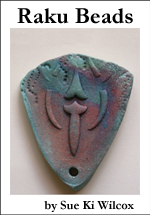|
|
|
December 2003 - Issue #15 In This Issue Hi Gary, When your reader was asking about the advisability of firing freshly glazed pots, one of my first thoughts (after agreeing that the top of the kiln is a good place to finish drying freshly glazed pots) was that I always put a cool scrap of soft brick on the hot kiln shelf before placing a pot on it. Many times, the shock of placing the pot on a hot shelf is the cause of cracking or worse, and besides, it means that if a glaze runs off the foot, the mess is removed with the soft brick rather than ruining the shelf. You probably do the same, but it bears repeating, especially for beginners who might not think of it. I noticed that your very nice piece in 500 Bowls incorporates both copper matt and crackle glazes. My experience has been that these need different post-firing reduction environments, and that one of the hardest things is to get beautiful crackle adjacent to rich copper matt effects. Often, when I leave the pot out in the air to cool enough to get dramatic crackle, it's a bit too cool for the copper matt effects I'm seeking. If I reduce the copper matt quickly enough, the crackle is less distinct. Any tips that you've found to marry them happily? Again, thanks for sharing, Dan F. - Colorado As you probably saw in past issues of the Just Raku newsletter, I was
lucky enough to take a workshop from Piepenburg as well. I would agree
with your opinion of they guy. He is very caring and sharing. I usually let my kiln cool for about 10 minutes between firings and I
also use kiln stilts (in place of a brick), but a brick is a good idea as
well. Crackle and copper matte challenges me as well. The bigger problem I
have is the crackle typically wants to be fired hotter than the matte, so
I usually end up with a semi-gloss copper matte. The way I fire a "combo" piece is to pull the piece and hold
in the air about 8-10 seconds (normal for my matte firing). Then you want
to make sure you get a good flame (and later smoke) in your reduction
chamber to color the clay in cracks of the glaze. I also apply the crackle
glaze much thicker than the matte to help with the crackle effect as well.
A lot of times I just what the white as a contract and don't care if it
crackles as much as I would on a piece that was primarily just a crackle
glaze. Thanks for the feedback and input! * * * Dear Mr. Ferguson, Yeah, underglazes are meant to be used "under" a
"glaze." :) So you are correct. You can use these under a clear
crackle, and you should get pretty much the color of the underglaze as
applied, but in some cases the color is off. You may want to get a test
pot and glaze a strip of each * * * [In Response to reader email Rick H.] Hello, ~-~-~-~-~-~-~-~-~-~-~-~-~-~-~-~-~-~-~-~-~-~-~-~-~-~-~-~-~-~ . |
||
|
Books
Learn Dozens of Hints, Tips and Techniques in the free monthly newsletter Just
Raku Privacy Policy - Your email address or other personal information will only be used for this newsletter. It will never be given, rented, or sold to any other party for any other purposed. |
||
|
Gary R. Ferguson - Raku Artist (c) Copyright 2006, Gary R. Ferguson |
||



